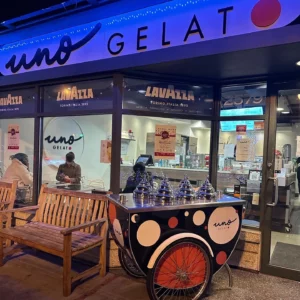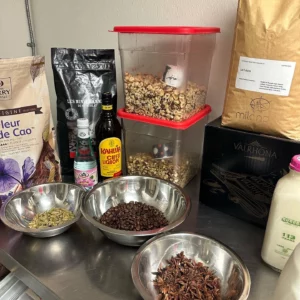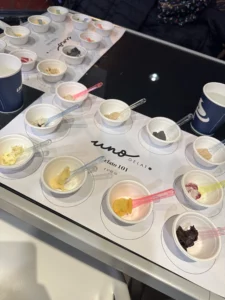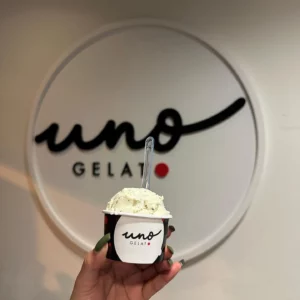Let’s talk gelato – the history, the making, and the tasting.
With the emergence of the Italian Renaissance, artistry changed in ways unlike it had ever before. Titian painted his Venus of Urbino, the Trompe-l’œil effect was being popularized in architecture, and Machiavelli was writing for hours a day to finish his political treatise, The Prince. Amidst all these creative pursuits, there was another historic piece of art being created by a simple chicken farmer in Florence, Italy.
Our story starts with the great Medici family of Italy– a tour de force during the Renaissance whose impact on art cannot be understated. They commanded power that the great American movers and shakers of the past 100 years could only dream of. More than just wealth accumulators, the Medicis were great patrons of art.
And so it is said that a member of the prominent family held a contest to search for the most unusual dish that could be created. The winner of the contest was a man named Ruggeri, who, despite being a chicken farmer by trade, was passionate about food and ended up creating the winning dish, a concoction of fruit juice and ice that is better known today as a sorbet. Ruggeri wasn’t cut out for the glitz and glamour that the Medicis bestowed on him for creating the treat and instead opted to go back to his domesticated farming life. However, his creation continued on.
Made with milk and cream instead of fruit juice like sorbet, gelato was created by Bernardo Buontalenti, who the Medici family commissioned to create a feast for the upcoming visit by the King of France. He created a mixture of cream flavored with bergamot, lemons, and oranges. The popularity of gelato continued to skyrocket from there.
It is important to note that Ruggeri and Buontalenti may have popularized the treats, but it didn’t start with them. The history of gelato-like delicacies has existed for as long as humans have had an inkling of a sweet tooth (and far predates the genesis of the term itself).
There are references in the Old Testament about drinking juice made of goat’s milk mixed with snow. The Pharaohs of Egypt were enamored with sweetened ice, and it said the Romans scoured the ice of Mount Vesuvius to eat it mixed with honey. Even the ancient Greeks, Alexander the Great being one of them, are said to have adored the ice and nectar treat.
This is all to say that the popularity and fine-tuning of these delicacies were inevitable. And while at times overshadowed by its more popular and full-bodied cousin, ice cream, gelato can be considered the more sophisticated and healthier of the two.
For most North Americans, ice cream evokes feelings of childhood nostalgia. We can still hear the ice cream trucks filling our neighborhoods with a cacophony of ragtime jingles. One by one, all the suddenly hungry kids would run inside to plead for a dollar bill from their parents, all for a popsicle that looked nothing like the picture on the wrapper.
Although the two may be used interchangeably, gelato and ice cream are quite different. One of the key differences between gelato and traditional ice cream is that the former uses less fat, and in order to prevent adding too much air, churns at a much slower speed than ice cream. Gelato, being warmer than ice cream, means that your tongue isn’t as numb as it usually is coated with cold ice cream. Therefore, the flavors are more robust and, thus, more striking. That’s right; it has a lower fat content and no brain freeze! But even more than these differences, more and more people are being taken by the silky texture and smoothness that it delivers. North Americans have begun to really explore the treat and have become allured by these luxuriant traits.
This brings us to Uno Gelato’s Gelato 101 class.

Nestled in between a nail salon and a children’s clothing store- Uno Gelato is located in Vancouver’s vibrant neighborhood of Kitsilano. The gourmet gelateria, with its colorful mobile gelato cart outside, fits right in with all the quirky specialty businesses in the area. The small store proudly hosts Gelato 101, an enormously popular gelato-making course that promises to turn beginners into “cone-noisseurs.” They pledge to pull back the curtain and teach the science of making gelato and sorbetto in the classic Italian method.
The class is run by gelato chef extraordinaire, the Emperor of Ice Cream himself, Maestro Andrés Bermúdez. Donning a tomato red double-breasted chef’s jacket, Bermúdez is cheerful, and his unbridled enthusiasm about the gelato process is infectious. When asked later about the title of Maestro, Bermúdez explained that it is a title bestowed to chefs who have years of experience in gelato-making, formal training, and an elite-level knowledge of the delicacy.
Originally from Bogota, Colombia, Bermúdez did not set out for a career in gelato-making. But, as luck would have it (and it often does), his friend ran a gelateria in Miami, and Bermúdez began working there as a server. From there, Bermúdez realized what would become his lifelong passion and eventually ended up in Vancouver, continuing and flourishing in his gelato-making career.

On a cold, rainy evening in January, my friend and I, along with a group of four other eager students, were buzzing with excitement to get a glimpse of the behind-the-scenes world of gelato. We were all provided with name tags and were called up by Bermúdez one by one and encouraged to stir, taste, measure, and smell the ingredients.
For our class, we were tasked to make a white star infusion gelato and mamey sorbetto. Previous classes have created seasonally themed flavors such as Pumpkin Pecan Bread, Tiramisu, Chocolate Grand Marnier, and Mango Chocolate Chili. Sorbet flavors have ranged from Lemon Basil to Blood Orange sorbetto. I tried the Mango Chocolate Chili, and it was fantastic! It was a complex flavor with three delicious layers, a totally different experience for your senses.
We sampled various types of sugars as Bermúdez explained that while most gelaterias use two different types of sugar, Uno Gelato uses six. This is to manage different levels of sweetness and control the sugar so it isn’t super sweet all the time. The sugars also contained different calories, leading to healthier alternatives for the gelato.
One thing you learn very quickly in the class is this: Gelato making is a science. Meticulous precision and knowledge of milk, cream, sugar, and their optimal temperatures and measurements are imperative for creating Italian-style sorbetto and gelato from scratch. The detailed and mathematical nature required gives one more appreciation for the frozen dessert.
Another key takeaway from the class is Uno Gelato’s commitment to using only the freshest ingredients in all its creations, and this simple fact sets them a world apart from competitors. They use milk and cream from Avalon Dairy, coffee beans from Milano Coffee Roasters, tea flavors from Granville Island Tea Company, and locally grown fruit. While they try to stay local as much as possible, Uno Gelato wants to have the best. As such, they import pistachios from Italy. They take their farm-to-cone approach seriously and show great pride in procuring the freshest and best ingredients for their customers.

Bermúdez says that 90% of gelaterias (Italian or otherwise) have given in to the pre-made industrialized process. He stated that fruit-flavored pastes and powders have become the norm as it is cheaper to cut labor costs and make the process much faster. However, the remaining 10%, Uno Gelato included, know that artisan gelato takes time. They don’t compromise on ingredients. Bermúdez stated that their process takes longer. They have to infuse the coffee beans for 24 hours and cook the condensed milk for 48 hours to make their in-house caramel. They take their time cutting the pineapples and squishing the lemons. This slow and bona fide process ensures that you can taste the real thing. Also, due to its lack of powders and pastes, Uno Gelato’s creations are a healthier version as you can get your minerals and vitamins from the real fruit while also getting a fresh and elevated flavor.
While the gelato was undergoing the freezing process, we were served ten tasting samples of gelato and sorbettos, which the class was positively giddy about. Tasting the various gelatos, Bermúdez gave insight into each flavor and went into detail as to how they were created. This was amazing because it really heightened our senses, and we were able to appreciate each flavor individually for what it was. He spoke about each flavor with knowledge and passion only a Maestro can. We tried rich and bold flavors while simultaneously trying understated ones.
One of the flavors that stood out to me was the Persian flavor, Akbar Mashti. Bermúdez stated that he draws inspiration from all the different cultures of Vancouverites and tries to incorporate them into his gelato creations. The gelato contains saffron which is the most expensive spice in the world, and rosewater from the local market (of which Bermúdez is known by the vendor as ‘the guy who buys countless bottles of the flavored water’). Cut pistachios are roasted and salted to really enhance the dish. Exploding with complex flavors, the gelato was interesting and remarkable.

The class participants got to pick their favorite flavor and get it in a cone or cup. Despite all the fantastic choices, it was a toss-up for me between the sweetness of the black cherry and the slight menthol taste of the mint chocolate; I ultimately decided to go with the latter. Bermúdez stated that most places make mint gelato with paste, which is why it tastes too powerful and reminiscent of toothpaste. Alternatively, Uno Gelato’s mint gelato was made with fresh mint leaves, tasting unbelievably garden-fresh.
When asked what his most unusual creation was, Bermúdez replied salmon gelato! He explained that it was created for a sushi chef and was meant to be paired with other dishes. He stated that he liked being inventive with gelato. He even enjoys making alcoholic creations, having recently created a passion fruit prosecco for a private class of exclusive Soho House members.
Along with a cone or cup, our class also got pints of the two flavors we made as a class; the containers were held together by beautiful and, I’m told, award-winning- packaging. I was quick to share the flavors with my loved ones, proudly boasting that I had made it myself, a mini Maestro-in-training!
The entire experience of creating the tasty treat from scratch is one that is joyous and deeply satisfying. More than just making gelato, you become immersed in it, learning its history, science, and technique. Guided by Bermúdez, the creative Willy Wonka in his gelato factory, his passion for the process and the art of creating gelato is palpable, and it’s no surprise that his classes are always sold-out. His cheery disposition sprinkles itself on all the class participants. And why wouldn’t he be cheerful? Uno Gelato already has three locations and is soon to be featured at Cafe Artigiano shops throughout the city and has established itself in Vancouver’s competitive food scene. It’s clear that there is something special here. Their fresh gelato tastes delicious, even more so when one participates in the magic of creating it. This class gives you a new appreciation for the painstaking precision and craft required to come up with a great gelato.
When you’re eating gelato and learning how it’s made, one cannot help but marvel at how the dish is the result of thousands of years of perfected techniques. It is the ultimate amalgam of Old-world sweet treat desire and modern machinery techniques. It may have had its origins in a distant land, but luckily you don’t have to travel across the world to eat and create the transcendent dish; Uno Gelato in Kitsilano is close enough.

